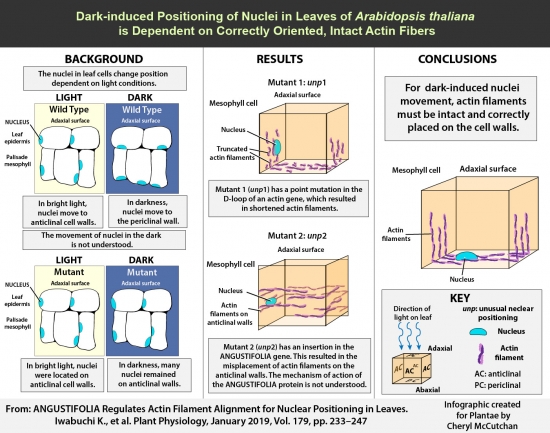What We’re Reading: February 1st
Happy February! This week we have a special issue featuring summaries written by candidates for the 2019 Plantae Fellows program. (Official announcement to follow soon).
Review: Deep learning on image-based plant phenotyping
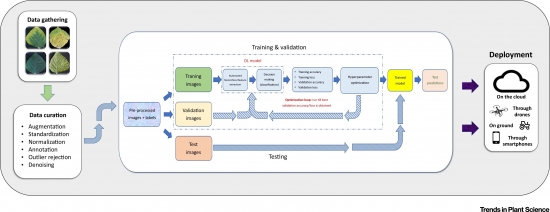 The development of deep learning brings opportunities to train computers to solve complex questions. Self-driving vehicles are classic examples of an application of deep learning in the real world. However, the large amounts of data that are required for building accurate models and avoiding overfitting problems were previously hard to accomplish in the plant science area. Fortunately, image-based plant phenomics can generate various types of images in a high-throughput way, which accelerates the connection between deep learning and image data. A recent review by Singh et al. summarizes the progress in this field and recapitulates the deployment of deep learning on ICQP (Identification; Classification; Quantification; Prediction). The authors also introduce current popular deep learning frameworks on disease detection and plant architecture identification. The summarized methods will be a valuable guide for computational biologists to refine their research topics and select appropriate deep learning models for corresponding questions. (Summary by Zhikai Liang) Trends Plant Sci. 10.1016/j.tplants.2018.07.004
The development of deep learning brings opportunities to train computers to solve complex questions. Self-driving vehicles are classic examples of an application of deep learning in the real world. However, the large amounts of data that are required for building accurate models and avoiding overfitting problems were previously hard to accomplish in the plant science area. Fortunately, image-based plant phenomics can generate various types of images in a high-throughput way, which accelerates the connection between deep learning and image data. A recent review by Singh et al. summarizes the progress in this field and recapitulates the deployment of deep learning on ICQP (Identification; Classification; Quantification; Prediction). The authors also introduce current popular deep learning frameworks on disease detection and plant architecture identification. The summarized methods will be a valuable guide for computational biologists to refine their research topics and select appropriate deep learning models for corresponding questions. (Summary by Zhikai Liang) Trends Plant Sci. 10.1016/j.tplants.2018.07.004
Mathematical modeling approaches in plant metabolomics
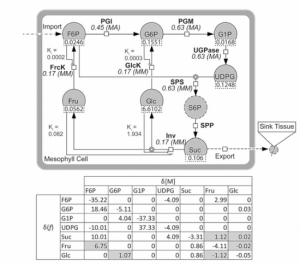 Mathematical modeling, as a series of useful methods for functional and causal interpretation of experimental high-throughput studies, enables us to explore the complex field of plant metabolism. The application of differential equations as a mathematical method has been developed and reviewed for decades and has been used to describe, analyze, and predict complex and nonintuitive system dynamics in plant biochemistry and physiology. Fittingly to the limited availability of kinetic information required, alternative approaches have been developed, e.g. system linearization, and parameter normalization. The quasi steady state Jacobian matrices are consequently introduced as an instrument for connecting metabolite concentrations and/or enzyme activities with biochemical network information. Even though statistical methods are an invaluable tool, it is recommended to combine them with biochemical information in order to enhance the reliability and predictive power of the output. In the context of metabolomic studies, this biochemical information can typically be derived from a genome-scale metabolic network. (Summary by Tina Ugulin) Fürtauer L., Weiszmann J., Weckwerth W., Nägele T. (2018) Mathematical Modeling Approaches in Plant Metabolomics. In: António C. (eds) Plant Metabolomics. Methods in Molecular Biology, vol 1778. Humana Press, New York, NY
Mathematical modeling, as a series of useful methods for functional and causal interpretation of experimental high-throughput studies, enables us to explore the complex field of plant metabolism. The application of differential equations as a mathematical method has been developed and reviewed for decades and has been used to describe, analyze, and predict complex and nonintuitive system dynamics in plant biochemistry and physiology. Fittingly to the limited availability of kinetic information required, alternative approaches have been developed, e.g. system linearization, and parameter normalization. The quasi steady state Jacobian matrices are consequently introduced as an instrument for connecting metabolite concentrations and/or enzyme activities with biochemical network information. Even though statistical methods are an invaluable tool, it is recommended to combine them with biochemical information in order to enhance the reliability and predictive power of the output. In the context of metabolomic studies, this biochemical information can typically be derived from a genome-scale metabolic network. (Summary by Tina Ugulin) Fürtauer L., Weiszmann J., Weckwerth W., Nägele T. (2018) Mathematical Modeling Approaches in Plant Metabolomics. In: António C. (eds) Plant Metabolomics. Methods in Molecular Biology, vol 1778. Humana Press, New York, NY
Expression of the nitrate transporter gene OsNRT1.1A/ OsNPF6.3 confers high yield and early maturation in rice
 In many ecosystems, nitrogen (N) is a limiting factor for plant growth. In agro-ecosystems, the application of synthetic N fertiliser has solved that issue. However, N fertiliser application is costly both to the farmers and the environment (in terms of N leaching and atmospheric release of greenhouse gases). In plants, the basic physiology and biochemistry of N uptake, assimilation and remobilisation towards the seeds, have been mostly elucidated. At the molecular level, the characterisation of genes encoding nitrate transporters has proven both interesting from a fundamental biology viewpoint (e.g., AtNRT1.1 being described as transceptor or membrane protein that function both in transport and signalling) and useful in providing options for improving nitrogen use efficiency (NUE) in crop. Here, Wang et al. have characterised the role of OsNRT1.1a in regulating N-utilisation as well as flowering-related genes in different rice backgrounds and Arabidopsis thaliana. Using mutants deficient in both OsNRT1.1a and OsNRT1.1b as well as over-expressor lines, the authors demonstrate that OsNRT1.1a is a good candidate for improving NUE in rice under both low and high N availability. (Summary by Stéphanie Swarbreck) Plant Cell 10.1105/tpc.17.00809
In many ecosystems, nitrogen (N) is a limiting factor for plant growth. In agro-ecosystems, the application of synthetic N fertiliser has solved that issue. However, N fertiliser application is costly both to the farmers and the environment (in terms of N leaching and atmospheric release of greenhouse gases). In plants, the basic physiology and biochemistry of N uptake, assimilation and remobilisation towards the seeds, have been mostly elucidated. At the molecular level, the characterisation of genes encoding nitrate transporters has proven both interesting from a fundamental biology viewpoint (e.g., AtNRT1.1 being described as transceptor or membrane protein that function both in transport and signalling) and useful in providing options for improving nitrogen use efficiency (NUE) in crop. Here, Wang et al. have characterised the role of OsNRT1.1a in regulating N-utilisation as well as flowering-related genes in different rice backgrounds and Arabidopsis thaliana. Using mutants deficient in both OsNRT1.1a and OsNRT1.1b as well as over-expressor lines, the authors demonstrate that OsNRT1.1a is a good candidate for improving NUE in rice under both low and high N availability. (Summary by Stéphanie Swarbreck) Plant Cell 10.1105/tpc.17.00809
Auxin efflux carrier ZmPGP1 mediates root growth inhibition under aluminum stress
 Acid soils (pH < 5.5) mobilize aluminum (Al) in the rhizosphere, which damages the root meristem and hinders exploration for nutrients and water. Zhang et al. demonstrate that a mutation in ZmPGP1, an auxin transport protein, imparts enhanced root growth under toxic Al conditions. The enhanced root growth is attributed to greater auxin accumulation, which leads to the upregulation of auxin response genes that sustain growth. Furthermore, organic acid membrane transporters, which help to mobilize Al in the rhizosphere, are upregulated in the mutant. (Summary by Nathan Scinto-Madonich), Plant Physiol. 10.1104/pp.17.01379
Acid soils (pH < 5.5) mobilize aluminum (Al) in the rhizosphere, which damages the root meristem and hinders exploration for nutrients and water. Zhang et al. demonstrate that a mutation in ZmPGP1, an auxin transport protein, imparts enhanced root growth under toxic Al conditions. The enhanced root growth is attributed to greater auxin accumulation, which leads to the upregulation of auxin response genes that sustain growth. Furthermore, organic acid membrane transporters, which help to mobilize Al in the rhizosphere, are upregulated in the mutant. (Summary by Nathan Scinto-Madonich), Plant Physiol. 10.1104/pp.17.01379
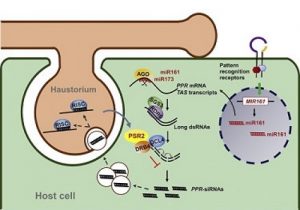
Plant-pathogen arms race: A pathogen effector protein inhibits trans-kingdom RNAi
Phytophthora spp. are highly aggressive fungus-like pathogens that cause various blight and rot diseases in many crops. Upon invasion of host cells, Phytophthora delivers thousands of effector proteins. Some of these effectors suppress the host RNA silencing pathway, which is mediated by a diverse group of small RNAs including microRNAs (miRNAs), and small interfering RNAs (siRNAs). Hou et al. show that a Phytophthora effector specifically inhibits miRNA-triggered secondary siRNA biogenesis from a group of Arabidopsis transcripts mainly belonging to the PPR gene family. The production of these secondary siRNAs (and their corresponding miRNA triggers) is induced in Arabidopsis as a defense response to Phytophthora capsici infection. Arabidopsis delivers these secondary siRNAs packaged within extracellular vesicles to silence effector transcripts in Phytophthora. The authors showed that introducing some of these secondary siRNAs into Phytophthora decreased its growth and its ability to cause disease. Secondary siRNAs have also been implicated in other plant-pathogen interactions. The findings by Hou et al. further confirm a conserved role of secondary siRNAs in trans-kingdom RNAi. (Summary by Saima Shahid) Cell host & Microbe 10.1016/j.chom.2018.11.007
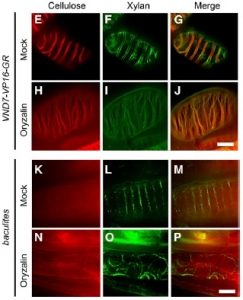
Xylan and lignin deposition are independent of cellulose in the secondary cell wall
The secondary cell wall (SCW) plays an important role in the structural integrity of plants and is key to efficient water conductivity. Despite the important role of the SCW, little known about how and when SCW components are assembled. Currently, it is understood that cellulose deposition is a precursor for other components including hemicelluloses and monolignols. A new study from Takenaka et al. is refining the spatial and temporal deposition requirements with regards to the role of cellulose in SCW assembly. Using an inducible expression system to drive expression of two transcription factors that determine metaxylem or protoxylem vessel cell fate and a forward genetic screen, a novel CELLULOSE-SYNTHASE SUBUNIT 7 (CESA7) mutant was identified and named bactulites or cesa7bac. The SCWs in cesa7bac protoxylem vessel cells lack cellulose while the deposition of xylan and lignan are unaffected. Further treatment of the cells with oryzalin, a chemical which depolymerizes microtubules, revealed that the xylan deposition no longer occurred. Taken together, this work reevaluates current understanding of SCW formation and establishes that deposition of xylan and lignin are independent of cellulose deposition. (Summary by Nick Segerson) Plant Cell 10.1105/tpc.18.00292
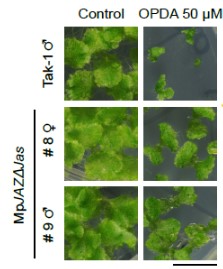
A single JAZ repressor controls the jasmonate pathway in Marchantia polymorpha ($)
Previously, Monte et al. showed that the liverwort Marchantia polymorpha perceives the jasmonate pathway precursor dn-OPDA instead of the well known JA-Ile phytohormone of vascular plants. Now, Monte and colleagues focus on the MpJAZ, downstream of the signal transduction pathway. MpJAZ is the sole ortholog in Marchantia to the 13 JAZ genes of Arabidopsis. In this paper, the authors studied the conservation of each relevant feature for JAZ genes in Marchantia. They found that while subcellular localization, protein-protein interactions, degradation by COI, and gene induction in response to wounding and OPDA are similar to vascular plants, but alternative splicing mechanism presents significant differences. The authors also showed that the knockout mutant mpjaz-1 presents a severe developmental abnormality, consistent with observations in Arabidopsis JAZ multiple mutants, and transcriptional changes demonstrating that the regulation of defense and secondary metabolism is conserved and dependent on COI1. This paper highlights the versatility of this model system to overcome genetic redundancy and provide new insights on transcription factor functional evolution. MpJAZ could resemble the “ancestral” state features of JAZ regulation and domain architecture, helping to understand how the entire family diversified and acquired new regulatory elements during evolution of vascular plants. (Summary by Facundo Romani) 10.1016/j.molp.2018.12.017
Speed breeding is a powerful tool to accelerate crop research and breeding ($)
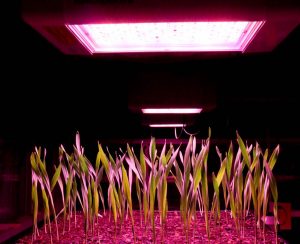 Accelerated development of improved plant varieties is imperative to meet the ever-growing needs in the agri-food sector. Breeding has been a durable solution for developing elite cultivars; however, the entire process is time-consuming and labor-intensive. Here, Watson et al. demonstrated how extending the photoperiod to a day-length of 22 hours could significantly shorten the generation time of crop species, yielding up to 4-6 generations per year instead of 2-3 generations per year under conventional conditions. The study shows that the flowering time of plants grown under speed breeding is approximately half the time of those from glasshouse conditions, resulting in early seed setting. (Summary by Muthamilarasan Mehanathan) Nature Plants 10.1038/s41477-017-0083-8
Accelerated development of improved plant varieties is imperative to meet the ever-growing needs in the agri-food sector. Breeding has been a durable solution for developing elite cultivars; however, the entire process is time-consuming and labor-intensive. Here, Watson et al. demonstrated how extending the photoperiod to a day-length of 22 hours could significantly shorten the generation time of crop species, yielding up to 4-6 generations per year instead of 2-3 generations per year under conventional conditions. The study shows that the flowering time of plants grown under speed breeding is approximately half the time of those from glasshouse conditions, resulting in early seed setting. (Summary by Muthamilarasan Mehanathan) Nature Plants 10.1038/s41477-017-0083-8
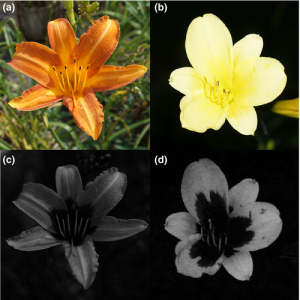
UV bullseye contrast of Hemerocallis flowers attracts hawkmoths but not swallowtail butterflies
Floral color and patterning each play a role in filtering pollinator visits to any given flower. However, just as the color and patterning of flowers is multidimensional, so too should be our understanding of the relative importance of color-related traits in pollinator preference. Hirota et al. aimed to determine how floral color-related traits (human-visible color and UV bullseye contrast) differentially influence pollinator attraction in two Hemerocallis species: H. fulva, which is orange and butterfly pollinated, and H. citrina, which is yellow and hawkmoth pollinated. Both species have UV bullseye nectar guides, however the constrast of the UV reflecting periphery of the bullseye in H. citrina is significantly more intense than in the H. fulva. The authors planted an array of both species of flower in outdoor plots and conducted pollinator observations, after which the individual floral color and UV pattern of each flower visited was noted. Contrast was key in Hawkmoth preference; Hawkmoths observed during both day and night significantly preferred flowers with higher UV contrast but made little to no distinction between human-visible floral colors. Conversely, butterflies showed a clear preference for H. fulva-like floral color (human-visible orange), yet little to no preference regarding UV contrast. Hawkmoths and butterflies differ in their visual perceptions of color: both are able to see UV, however butterflies are much more adept at discriminating between human-visible colors. Hirota et al’s findings reveal a marked distinction in responses to visual floral cues between pollinators and the potential that differences in visual perception of pollinators could drive floral divergence. Understanding sensory perception of pollinators is integral in unraveling the mysteries of pollinator-driven floral evolution. (Summary by Rebecca Hayes) Ecology and Evolution 10.1002/ece3.4604
Mechanisms of dark-induced nuclei positioning in leaves of A. thaliana
Iwabuchi et al. explored the contribution of actin fibers in proper orientation of nuclei in response to changing light conditions. Their findings are summarized below. Conclusion? For dark-induced nuclei movement, actin filaments must be intact and correctly placed along the cell walls. (Visual summary by Cheryl McCutchan) Plant Physiol. 10.1104/pp.18.01150
